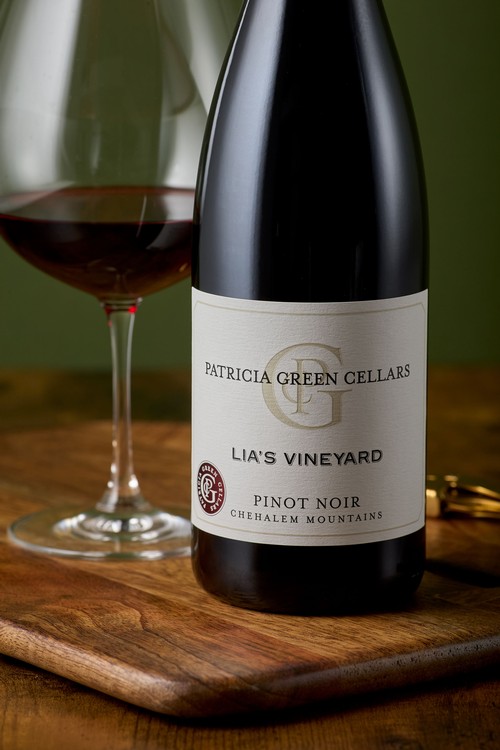2022 Lia's Vineyard Pinot Noir

Site History: Lia’s Vineyard was originally part of the land planted by Jan Jacobsen and Paul Hart (the original owner of Rex Hill Winery) as Jacob-Hart Vineyard in 1988. The couple owned the land and developing vineyard independent of the Rex Hill operations. When Rex Hill sold to A to Z Winery in the early 2000s, Jan and Paul retained ownership of the vineyard. In 2007 the site was broken into multiple blocks and sold to different buyers. Todd Hansen purchased this site. He still owns what is the upper section of the site although a portion of it drops below the level of the site below it, Corrine Vineyard.
Site Characteristics: Lia’s Vineyard is largely up the hill from the Corrine Vineyard in the Chehalem Mountain Appellation. In that part of the Chehalem Mountains vineyards lower on the hillside consist of marine sedimentary soils and vineyards higher on the hillside consist of volcanic soils. Lia’s Vineyard straddles that transition with sections of the vineyard toward the bottom being in marine soil and sections toward the top being planted in volcanic soil. The vineyard largely faces west with portions of it rolling off to the south and southwest with the western face being highly exposed and the southern face having some tree cover. Just as we have since 2012 when we finally got the blocks of our choice, we received Pommard planted in 1993 and Dijon 115 planted in 1999, the former in volcanic soil, the latter in the marine. There are two small (less than half an acre each) sections in the middle and bottom of Lia’s Vineyard planted to the Mariafeld Clone of Pinot Noir (also known as Clone 23). This is a very rare clone in Oregon and was something that we coveted from Day 1 back in 2009.
PGC Blocks: This is a diverse vineyard in terms of both clones and soil types which combine to give the resulting wine its characteristic nature.
• Dijon 115 : 1.75 acres. 1993 planting. Lia’s is divided into three sections that decrease in size as the vineyard goes up the hill. This is in the lower, largest bottom section planted in marine soil.
• Mariafeld Clone : .46 acres. 1999 planting. This is a very unusual and rare clone in Oregon. It is designed to be botrytis resistant and thus has an elongated and stringy shape to the clusters. This tends to be highly pigmented, highly acidic and quite tannic. A little goes a long way.
• Pommard: 2.0 acres. 1999 planting. This is in the middle section going up the hill and becomes quite steep in some places. Soil transitions at the bottom from marine sedimentary quite quickly into volcanic soil. A large portion of the plants in parts of the upper most portion of the block are no longer producing.
Farming Practices: There is perhaps no better of an example of the synergy of buyer and grower coming together to accomplish a change in farming that benefits all parties. This site has gone from quite casually farmed with the definite use of glyphosates for weed control to one that is now organically farmed with great attention to soil management and maintenance. All Patricia Green Cellars sites are dry farmed.
Picking Dates, Tonnages, Tons/Acre: September 15 Dijon 115 4.12 tons (2.35 tpa), September 21 Pommard 1.96 tons (about 2.o tpa), October 1 Mariafeld 1.56 tons (3.39 tpa).
Vinification: All fruit from Lia’s Vineyard was destemmed in 2021.
Winemaking: Fermentations were managed by a combination of pumpovers early in the process and exclusively prior to fermentation beginning as well as pigeages to ensure gentle handling, extraction and delicate tannin construction. Cold soaks were generally 3-4 days with the exception of the Mariafeld which was between 5-6 days. Full fermentation from beginning to pressing was 16-17 days except for Mariafeld which was 18 days. 48-72 hour settling prior to being racked to barrel. All wines on full lees until assemblage for bottling. Bottled without fining or filtration.
Barrels: This 16-barrel bottling consists entirely of neutral barrels with the exception of 2 new barrels used on the Dijon 115. Wine was in barrel until late June and bottled in late July. Bottling consists of:
• Dijon 115: 11 barrels
• Mariafeld: 1 barrel
• Pommard: 4 barrels
Notes: As the only wine in our lengthy portfolios of Pinot Noir that crosses over our two notable categories of soil type, Lia’s Vineyard has an expression to it that is distinct from all our other wines. As it should. The Pommard in the upper portions of our blocks provides the sweetness of fruit in both the aromatics and flavor while giving a silky impression in the mid-palate. The lower situated Dijon 115 in marine soil provides more structure as well as infusing minerality and slight earth tones. The one barrel of Mariafeld is the grout that pulls these disparate features together and makes them harmonious. With this vineyard’s vines now ranging from 20-30 years in age, the site having gone a farming transformation over the past 3-4 years and a re-dedication to making this bottling that began with the 2016 vintage, this wine now is far more than informational and instructional about how the combined soils show together in a single wine. This is wine with soaring aromatics that promises to have a long future of slowly unwinding while still being immensely drinkable with a mix of red and black fruits washing over a nicely tight structure of youthful tannins in the here and now. It has finishing numbers of 6.0 TA, 3.53 pH, a free SO2 under 25 ppm and a total SO2 under 65 ppm.

